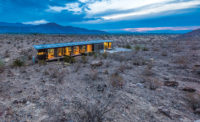New York, New York
Color, texture, a refined yet offbeat sense of materiality, and above all, a subtle irreverence are staple elements of fashion designer Consuelo Castiglioni’s collections for Marni, the upscale Milanese label she founded in 1994 with her husband, Gianni, the company’s C.E.O. A favorite of confident, creative women, Castiglioni’s exuberant designs are intended to reflect her customers’ persona and style as much as her own. Likewise, the 38 independent and the numerous shop-in-shop Marni retail outlets worldwide—designed by Castiglioni in collaboration with the London-based architectural firm Sybarite—speak to both the brand’s image and the locales in which the stores reside.
Completed in April, Marni’s second New York City flagship store occupies a former art-gallery space on the first two floors of a five-floor town house (circa 1900) on East 67th Street, just west of Madison Avenue and close to some of the city’s most exclusive boutiques and galleries. Picking up on the neighborhood’s verve, Castiglioni and the architects created a stylized interpretation of a modern art gallery—for clothing and accessories—leaving the building’s French Neoclassical–facade virtually intact. The only exterior alterations—replacing a small display window and traditional paneled door with full-height glass versions—provide passersby with a glimpse of what’s inside. These contemporary elements also supplement the daylight from three existing casement windows on the second floor above a newly devised 2-story lobby entrance.
Castiglioni’s eclectic aesthetic informs the interior of the quirky, 2,700-square-foot split-level shop. Intentionally rough, roller-painted white swaths on drywall contrast with a delicate lilac carpet and folded, origami-inspired white lacquered-steel panels that meander along the walls and behind various displays. Dynamic polished-stainless-steel racks undulate throughout the space. Meanwhile, light acts as one of the driving forces behind the entire design. Architect Simon Mitchell, Sybarite’s director, notes that he decided from the start to respond to the 88-by-18-foot, multilevel space by creating large geometric shapes in light and opening up the store with structural cutouts.
Demolishing an existing stair enabled Mitchell and his design team to make a diagonal incision between the two floors to create a nearly 18-foot-high foyer. A cluster of diaphanous fiberglass mannequins sporting Castiglioni’s whimsical ensembles floats in this double-height space, which is toplit by the first of four super-size ceiling luminaires that brighten and visually expand the upper floor. The designers used the same device in the back of the shop, where a treelike clothes rack on the first floor rises through a trapezoidal hole beneath a giant illuminated circle. Glass knee walls, ranging from 30 to 37 inches high, border these openings and line the stair to maintain the desired sense of openness.
Carved into the ceiling, the large luminaires are custom fabrications with warm 2700K fluorescent T5 and T8 lamps installed in the plenum and staggered in plan at least 12 inches above a formable, nonflammable stretch ceiling material chosen for its light weight, translucence, and ability to cover expansive areas. Chamfered edges around the perimeters produce fine shadow lines that define the forms etched within the flat ceiling. Downstairs, similar but smaller round fixtures, in varying diameters, are fitted with opalescent glass diffusers set flush with the ceiling. The lighting on both levels emits a pleasing theatrical glow with a good color rendering and a minimum of shadows.
“Fluorescents are getting much better,” says Mitchell. In addition to improved color temperatures, they generate less heat, he notes. So the deep, narrow shop, with only three operable windows, requires less air- conditioning than is typical for an establishment with such a configuration, reducing operating costs already lowered because this cooler light source consumes less energy than its incandescent counterparts.
The designers did use incandescent lamps where they wanted sparkle and finely tuned direction. “We have only about 35 halogen lights in the entire shop,” says Mitchell. These include PAR30 downlights on a track system adjacent to the stairs that direct light to the treads, the tiers of handbags along the opposite wall, and the path between them. The same fixtures ring the circular fluorescent luminaire upstairs to highlight the garments hung on the stainless-steel rail that surrounds the trapezoidal cutout in the floor. In addition, 20-watt dichroic halogen spots cast a gentle glow on lingerie displayed in sumptuous leather-lined boxes.
The project’s successful lighting scheme supplies surprisingly even and glare-free illumination, providing an artful, vibrant backdrop for the shop’s fashionable merchandise. “I love this light,” says Castiglioni. “It’s like daylight,” she adds. “And it gives a freshness to this new boutique.”


